




In this episode we talk to Mallory O’Meara – horror screenwriter, producer and the author of The Lady from the Black Lagoon. Join us as we discuss the book which features the story of Milicent Patrick, the creator of Gill-man from the film Creature from the Black Lagoon. He was, and still is, one of the most recognizable monsters in cinema history alongside Dracula, Frankenstein and the Wolfman. For decades the credit for the creation of the creature was given to Bud Westmore, the head of the Universal makeup department, who fired Patrick rather than have her role in the creature’s success become known. This book sets out to right this wrong.
O’Meara discusses her obsession with bringing Patrick’s story out of the murky swamp and into the light, the almost impossible journey it took to uncover the truth, dealing with the haters in horror after she did. She talks openly about what it is like to be a woman in the horror industry today — and how very little has changed, and what it was like growing up as a girl who loved monsters.
Podcast: Play in new window | Download
Listen Now
Patrick was an actress, makeup artist, special effects designer and animator. She was the first female animator at Walt Disney Studios and creator of the head costume for the iconic Gill-man from the movie Creature from the Black Lagoon.
She headlined a tour in promotion of the Creature from the Black Lagoon, titled ‘The Beauty who Created the Beast’, but on her return she was fired by Bud Westmore, who is noted as objecting to a woman’s being credited with the work on the costume.
Patrick began an affair with fellow animator Paul Fitzpatrick. Upon the death of Fitzpatrick’s wife from suicide, the couple married in 1945. Their relationship was the source of estrangement from Patrick’s own family. The marriage lasted only a few years. Patrick then had a relationship with voice actor Frank L. Graham in 1950. Several weeks after she ended their relationship, Graham died from suicide at his home. After a tumultuous relationship marked by cancelled engagements, Patrick married Lee Trent in a Las Vegas chapel wedding in December of 1963. They filed for divorce in January 1969, but continued to have an on-off relationship for years. She died from breast cancer in 1998.
Recently, the Academy has been holding screenings and lectures with Mallory O’Meara, discussing Patrick’s important contribution to cinema.


Posey was dubbed by Time Magazine as the “Queen of Indies” after starring in such cult hits as Dazed and Confused, Party Girl and The House of Yes. She later played unforgettable improvisational roles in Christopher Guest mockumentaries, including Waiting for Guffman and Best in Show. She has gone onto create memorable roles in both TV and film and is currently Dr. Smith in the Netflix reboot of Lost in Space. Her memoir, You’re on an Airplane, proves that Posey is not only a film icon, but also a talented writer. In this episode she talks about her road from soap opera actress to indie queen, how much the business has changed since her start, growing up with a cast of characters, how she paved her own way outside of the Hollywood machine, and how it’s important to always show up for friends.
Podcast: Play in new window | Download
Listen Now
Actress and activist Mary Tyler Moore, known for her groundbreaking roles in the television sitcoms The Mary Tyler Moore Show and The Dick Van Dyke Show in which her characters often broke from stereotypical images of women and pushed gender norms, became a cultural icon and served as an inspiration for many younger actresses, professional women, and feminists. Her film work includes 1967’s Thoroughly Modern Millie and 1980’s Ordinary People, in which she played a role that was very different from the television characters she had portrayed, and for which she was nominated for an Academy Award for Best Actress. She went on to do important charity work, particularly the issues of animal rights, vegetarianism and diabetes. She was diagnosed with type 1 diabetes early in the run of The Mary Tyler Moore Show and also suffered from alcoholism, which she wrote about in her first of two memoirs.


Han exists primarily as the one-human show Handsome Devils Puppets. A self taught sculptor and puppeteer, touring storyteller and songwriter, her creative journey is about much more than creating art, it is a means of self-expression. “I started making puppets when I felt I didn’t have a voice. I sculpted powerful, magical creatures to dance and sing and cry and give me that voice.” In this episode, Han talks about growing up in a strict Catholic household in Kansas and how that shaped her and her art, her background in costume design, her love of murder ballads, her battle with anxiety and how her puppets are her proxy for interacting with the world, how she deals with life’s tragedies through her art and how not revealing her full name and moving to a different city every few years helps her cope and keeps her sane.
Han will be touring the West Coast soon, so check out her website for upcoming performances and follow her on instagram to see her custom puppets which include Merricat Blackwood — the main character from Shirley Jackson’s We Have Always Lived in the Castle, Sylvia Plath, post mortem babies, Frida Kahlo, Wednesday Addams, Vampira and David Bowie. This episode is a must-listen for creative souls forging their own paths and struggling to cope with life in general.
Podcast: Play in new window | Download
Listen Now
Édith Piaf was one of the most iconic performers of her native country France. She was a singer, songwriter, cabaret performer and film actress noted as France’s national chanteuse and one of the country’s widely known international stars. Piaf’s music was often autobiographical and she specialized in chanson and torch ballads about love, loss and sorrow. Also known as “The Little Sparrow,” Piaf was born in Belleville, on the outskirts of Paris, on December 19, 1915 and she struggled from day one as the daughter of street performers. Her mother, a singer, eventually abandoned both Edith and her father for a solo career. Piaf spent her youth entertaining passers-by, receiving little formal education in the process. An aborted love affair left her with a baby girl at age 17, but little Marcelle died of meningitis at 2 years old. Devastated, Piaf returned to the streets she knew, now performing solo.
Her fortunes finally changed when an impresario, Louis Leplee, mesmerized by what he heard, offered the starving but talented urchin a contract. Piaf grew in status entertaining in elegant cafés and cabarets and became a singing sensation amid the chic French society with her throbbing vocals and raw, emotional power. From 1936 Piaf recorded many albums and eventually became one of the highest paid stars in the world. She was first embroiled in scandal when her mentor, Leplee, was murdered and she was held for questioning. Piaf also took to writing and composing around this time; one of the over 80 songs she wrote included her signature standard, “La vie en rose.” Although she appeared sporadically in films, it was live audiences that sustained her.
Two serious car accidents suffered in 1951 led to a morphine and alcohol addiction that left Piaf’s life skidding out of control despite a potentially happy marriage in 1952 to actor Jacques Pills. She died in poverty at the age of 47, the same age as her equally tortured American counterpart, Judy Garland.


Palmer is a singer, songwriter, musician, author and performance artist with an experimental bent. Beginning her career as one half of the beloved “Brechtian punk cabaret” duo Dresden Dolls, she embarked on a solo career in 2007 releasing acclaimed solo albums and collaborations with Ben Folds, Jherek Bischoff, Brendan Maclean, her father, Jack Palmer, and her husband, writer Neil Gaiman. November 2014 saw the release of Palmer’s part memoir/part self-help book, The Art of Asking: How I Learned to Stop Worrying and Let People Help by Grand Central Publishing. It became a New York Times bestseller, and is considered one of the definitive works about crowd-funding and getting things done outside the system. Join us as she opens up about her personal life – her marriage to Neil Gaiman, giving birth to her son Ash – her latest projects and striking the balance between protecting her family’s privacy and her artistic ambition to live her life as an open book.
Podcast: Play in new window | Download
Listen Now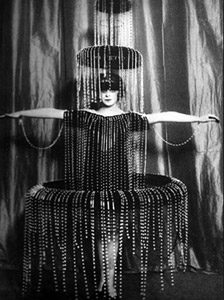
Decadently eccentric and fashionably forward-thinking Italian heiress Marchesa Luisa Casati was a muse for the Futurists and Symbolists, Fauves, Futurists and Surrealists. She was an amazingly charismatic woman and patron of the arts, whose parties and appearances at others became legendary. With flaming red hair, black-rimmed green eyes, tall, thin and androgynous silhouette, she has long been considered the first ‘dandy’ of the early 20th Century. She was famous for wearing live snakes as jewelry, for her diamond leashed cheetahs and for her life of scandalous excess. Dressing up was the chief embodiment of her creative vision, a type of living theatre, where there was no discernible difference between costumes and clothes – a most modern, Warholian sensibility which led her to once declare, “I want to be a living work of art.” She died penniless and was buried alongside her taxidermied Pekingese, only adding to her inimitable legend.


In this special Easter edition, just in time for the Catholic funeral processions, we feature Catholic relic hunter and creator of the All the Saints You Should Know blog Elizabeth Harper. Harper travels the word to photograph and write about the unusual (and often macabre) things she finds in Catholic churches—incorrupt corpses, holy relics (which are often the preserved body parts of saints), memento-mori tombs, exotic taxidermy and human bone art. Currently, her photographs of incorrupt saints are featured in the Metropolitan Museum of Art’s catalog Like Life: Sculpture, Color and the Body. Join us as Harper opens up about growing up catholic, how she related to saints as a young girl –especially Catherine of Sienna the patron saint of eating disorders, when Harper suffered from anorexia and what Holy Week in Zamora, Spain is really like – what happens in Zamora stays in Zamora.
Podcast: Play in new window | Download
Listen Now
Mrs. Cruz was a native of New Orleans, LA, and was educated by the School Sisters of Notre Dame. She was a member of the Discalced Carmelite Secular Order for 50 years and received the Mother Teresa Award in 2005. Mrs. Cruz was the author of 15 Catholic books, all of which received the imprimatur. She was perhaps best known for her writings on miraculous occurrences of faith which she compiled through meticulous research of foreign shrines, churches, convents and monasteries. She is perhaps best known for her book The Incorruptibles: A Study of Incorruption in the Bodies of Various Stains and Beati.


Cassandra Peterson is an actress, comedian and entrepreneur born in Manhattan Kansas in 1951. She is best known for her longtime portrayal of the legendary horror hostess character Elvira, Mistress Of The Dark, which she created for local Los Angeles television station KHJ-TV in the early 1980s. Her sexy gothic look, dark humor and Valley Girl speak were an instant hit, attracting a national audience for Elvira’s Movie Macabre, her weekly horror movie show, and making Peterson the only nationally syndicated horror host in history.
Join us for a tell-all interview with the Queen of Halloween as she discusses the ups and downs of her fascinating life and career — from go-go dancer at the age 14 to Vegas showgirl at 17, hanging out with Jimi Hendrix, dating Elvis and losing her virginity to Tom Jones, joining the Groundlings with her friend Paul Reubens, balancing being a brand and a personal life, as well as some horrific casting couch experiences, #MeToo moments, divorce and and how she overcame it all to ultimately become an icon.
Podcast: Play in new window | Download
Listen Now
Actress, singer, comedian, playwright, screenwriter and sex symbol Mae West did it all and did it first, inspiring and entertaining generations throughout her seven decades long career. Known for her lighthearted bawdy double entendres, and breezy sexual independence, West made a name for herself in vaudeville and on the stage in New York City before moving to Hollywood to become a comedian, actress, and writer in the motion picture industry, where she became one of the first truly modern women on screen and off.
Mae wrote 9 of 13 films she starred in and her quotes are still used by women of all ages today. Her outspokenness made her one of the more controversial movie stars of her day. She encountered many problems, especially censorship. She bucked the system, making comedy out of prudish conventional mores, and the Depression-era audience admired her for it. In short, Mae found a way. Asked about the various efforts to impede her career, West replied: “I believe in censorship. I made a fortune out of it.”


This week’s guest, Lydia Lunch, is passionate, confrontational and bold. Whether attacking the patriarchy and their pornographic war mongering, turning the sexual into the political or whispering a love song to the broken hearted, her fierce energy and rapid fire delivery lend testament to her warrior nature.
Queen of No Wave, muse of The Cinema of Transgression, writer, musician, poet, spoken word artist and photographer, she has released too many musical projects to tally, has been on tour for four decades, has published dozens of articles, half a dozen books, appeared in numerous documentaries, conducted workshops and taught at Universities and simply refuses to shut up. Lucky for us! Listen to Lunch talk about everything from Louis C.K., the #MeToo movement and the Golden Globes to growing up abused and hustling her way to survival on the streets of New York City in this essential episode of in-your-face timely truths.
Podcast: Play in new window | Download
Listen Now
Madalyn Murray O’Hair was an activist, founder of American Atheists, and the organization’s president from 1963 to 1986. She created the first issues of American Atheist Magazine. O’Hair is best known for the Murray v. Curlett lawsuit, which led to a landmark Supreme Court ruling ending official Bible-reading in American public schools in 1963. That case came just one year after the Supreme Court prohibited officially sponsored prayer in schools in Engel v. Vitale.
In 1995, O’Hair, her son Jon, and her granddaughter Robin disappeared from Austin, Texas. They were later found to have been kidnapped, murdered and mutilated by three men – including a convicted felon on parole and a fellow career criminal.


This episode we dive deep into the beehive for a wide ranging discussion with legendary B-52s singer, songwriter, multi instrumentalist and small business owner Kate Pierson! The post punk pioneer and kitsch culture icon talks growing up in NJ, the band’s punk and New Wave beginnings in Athens, GA, their rise in the gritty New York City music scene in the 1970s – the first band to play the infamous Mudd Club, the band’s thrift store chic fashion, the decision to carry on after the AIDS related death of bandmate Ricky Wilson and their worldwide success in the late 80s and 90s, her unforgettable collaborations with REM, Iggy Pop, The Ramones and Sia and her more recent adventures as a motel keeper in Woodstock. Tune in to find out what it was like then and what it’s like now to be an artist, to be an entrepreneur, to be a woman in music, to be Kate Pierson.
Podcast: Play in new window | Download
Listen Now
At the age of nine Mitchell, the Canadian born singer/songwriter, contracted polio and turned her attention away from athletics and focused more on creative talent, eventually becoming one of the most important singer-songwriters of her generation. Rolling Stone called her “one of the greatest songwriters ever” and AllMusic has stated, “When the dust settles, Joni Mitchell may stand as the most important and influential female recording artist of the late 20th century.” Drawing from folk, pop, rock, and jazz, Mitchell’s songs often reflect social and environmental ideals as well as her feelings about romance, confusion, disillusionment, and joy. Throughout her career, she has won various accolades, including 9 Grammy Awards.


This week we welcome Kat Kinsman for a special Thanksgiving edition. Kat is the Food and Drinks Editor at Time Inc.’s all-breakfast site Extra Crispy and the author of the book Hi, Anxiety: Life with a Bad Case of Nerves. Previously, she was an Editor at Large and Editor in Chief of Tasting Table. the Managing Editor of CNN’s Eatocracy, edited CNN’s Matrimony section and First Person essay series and was a writer and editor for CNN Living. Join us as we talk holiday food and drink, anxiety & depression, finding your tribe, day-in-the-life of a dominatrix & the magic of whiskey sours and much more!
Podcast: Play in new window | Download
Listen Now
Cowin is the former chief creative officer of Chefs Club International and editor of Food & Wine magazine. During her decades-long tenure as editor in chief, she was instrumental in shifting the way people think about and interact with the food world. She now hosts the podcast Speaking Broadly where she conducts intimate interviews with brilliant, powerful women in the food world about their lives and careers.
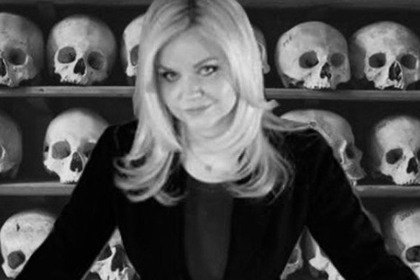

This week we welcome Dr. Lindsey Fitzharris—storyteller, medical historian and author of The Butchering Art: Joseph Lister’s Quest to Transform the Grisly World of Victorian Medicine. Fitzharris received her doctorate in the History of Science, Medicine and Technology at the University of Oxford. She is the creator of the popular website The Chirurgeon’s Apprentice, and she writes and presents the YouTube series Under the Knife. Join us as we talk about her love of storytelling, the gruesome history of Victorian medicine, surgery horrors, the importance of failure, reinventing yourself after divorce and growing up in Illinois with a grandmother who loved cemeteries.
Podcast: Play in new window | Download
Listen Now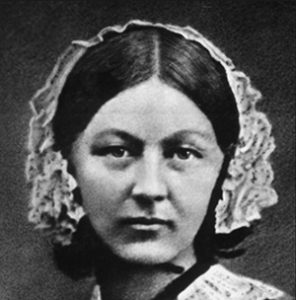
Strange Women Throwback for this week’s episode is Florence Nightingale. Nightingale was a trailblazing figure in nursing who greatly affected 19th- and 20th-century policies around proper care. She was known for her night rounds to aid the wounded, establishing her image as the ‘Lady with the Lamp.’ She was born in Florence, Italy, on May 12, 1820. Part of a wealthy family, Nightingale defied the expectations of the time and pursued what she saw as her God-given calling of nursing. During the Crimean War, she and a team of nurses improved the unsanitary conditions at a British base hospital, greatly reducing the death count. Her writings sparked worldwide health care reform, and in 1860 she established St. Thomas’ Hospital and the Nightingale Training School for Nurses. A revered hero of her time, she died on August 13, 1910, in London.


Join us for a special Halloween edition of Stories of Strange Women podcast as we welcome book critic and award-winning Shirley Jackson biographer Ruth Franklin! In this episode we explore Franklin’s epic biography Shirley Jackson: A Rather Haunted Life — discussing Jackson taking her crown as the queen of horror, being a female writer in the 40s and 50s, managing a demanding husband, four children and work, growing up as an outsider with a verbally abusive mother, her struggle with mental illness, Jackson as a feminist and her reputation as a witch.
Franklin is a former editor of The New Republic. Her biography, Shirley Jackson: A Rather Haunted Life won the National Book Critics Circle Award for Biography and was named a New York Times Notable Book of 2016, a Time magazine top nonfiction book of 2016, and a “best book of 2016” by The Boston Globe, the San Francisco Chronicle, NPR, and others. In The Washington Post, Elaine Showalter called it “a sympathetic and masterful biography that both uncovers Jackson’s secret and haunting life and repositions her as a major artist.”
Franklin’s work appears in many publications, including The New Yorker, The New York Times Book Review, The New York Review of Books, and Harper’s. She is the recipient of a Guggenheim Fellowship in biography and a Cullman Fellowship at the New York Public Library.
Podcast: Play in new window | Download
Listen Now
Shirley Jackson is one of the most brilliant and influential authors of the twentieth century. She was popular during her life and her work has received increased attention from literary critics in recent years. She has been cited as an influence on a diverse set of authors, including Neil Gaiman, Stephen King, Sarah Waters, Nigel Kneale, Joanne Harris and Richard Matheson. She is best known for the short story “The Lottery” (1948), which reveals a secret, sinister underside to a bucolic American village, and for The Haunting of Hill House (1959), which is widely considered to be one of the best ghost stories ever written.[3] In her critical biography of Jackson, Lenemaja Friedman notes that when “The Lottery” was published in the June 26, 1948, issue of The New Yorker, it received a response that “no New Yorker story had ever received.” Hundreds of letters poured in that were characterized by, as Jackson put it, “bewilderment, speculation, and old-fashioned abuse.”
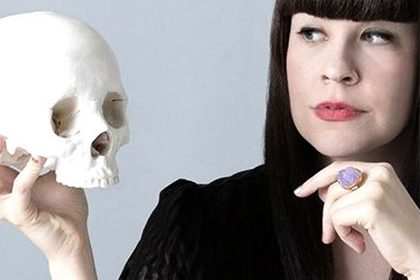

This week we welcome Caitlin Doughty — mortician, funeral home owner, the creator of the web series “Ask a Mortician”, founder of The Order of the Good Death, and author of the bestselling books Smoke Gets in Your Eyes & Other Lessons from the Crematory and From Here to Eternity. Doughty talks about growing up Goth in Hawaii, her road to getting published, owning a funeral home, and spearheading the death positive movement.
Podcast: Play in new window | Download
Listen Now
Worden was the director of the Mutter Museum in Philadelphia. She turned the little-known medical museum, which exhibits medical deformities, pathologies and medical anomalies, like the horned woman, the man with the giant colon, deformed fetuses and a plaster cast of the Siamese twins Chang and Eng Bunker, into a museum with a worldwide reputation. She put together a book of photographs from the museum’s collection of human oddities and outdated medical models and made several appearances on Late Night With David Letterman shocking him with such things as Victorian surgical tools and human hairballs. There was a serious message behind Worden’s sometimes madcap affect: that the human body is not to be feared or loathed, even when horrifically damaged or monstrously distorted. “While these bodies may be ugly,” she wrote in her book of the museum’s mute inhabitants, “there is a terrifying beauty in the spirits of those forced to endure these afflictions.”


This week we welcome legendary indie film producer Christine Vachon of Killer Films. Vachon has produced such works as Far From Heaven (nominated for four academy awards), Boys Don’t Cry (Academy Award winner), Hedwig and the Angry Inch, One Hour Photo, Velvet Goldmine, I Shot Andy Warhol, infamous, Mildred Pierce, Still Alice, Carol (Academy Award nominee for best picture), and most recently Wonderstruck. She talks about her long career, the state of indie film, her grassroots approach, battling breast cancer and so much more.
Podcast: Play in new window | Download
Listen Now
Gordon is said to be “known for her bold explorations of themes related to sexuality, violence and power.” Her film Variety, which Christine Vachon worked on in the edit room, explores the relationship between women, pornography and voyeurism. The title character of the film “turns the tables on men” by renegotiating the historically exploitative relationship between men and women with respect to pornographic films.
Gordon is now a part of the film department of Columbia University School of the Arts. Some of her films are part of the permanent collections in several different museums including the Museum of Modern Art and the Whitney Museum of American Art.


Sisters Tish and Snooky Bellomo are punk pioneers – they opened the first ever punk rock shop called Manic Panic on St Marks Place, NYC in 1977. Ramones, The New York Dolls, Blondie, Dead Boys, Patti Smith, Sid and Nancy were all fixtures at the store and on the scene. It was Manic Panic by day and CBGBs by night. Manic Panic sold clothes, whatever the sisters could find or make, and later makeup, accessories and finally hair dye for which they’re known worldwide. The sisters started out as backup singers for Blondie in 1975 and continue to sing backup (most recently for Patti Smith), as well as perform with their punk band the Sic F*cks. Theirs is the story of punk rock history and one not to be missed.
Podcast: Play in new window | Download
Listen Now
Tish and Snooky had many throwbacks, which you’ll hear in the episode – everyone from The Shangri-Las and The Exciters to their old friend, actress Cleo Rose. But Debbie Harry, most famous for leading Blondie, probably taught them most about what they’ve built their grassroots empire on — makeup and hair. The sisters sang back up for Blondie in 1975 and they never looked back. Debbie Harry is one of the most influential singers of all time, with her musical know-how and mesmerizing aesthetics, she became a pop icon, influencing many female singers to come.


Pam Grossman is the author of WHAT IS A WITCH, the WITCHEMOJI, an independent curator, writer, and teacher of magical practice and history. She is the creator of Phantasmaphile, a blog that specializes in art with an esoteric or fantastical bent and is working on the definitive book on witchcraft. Pam is also the Director of Visual Trends at Getty Images.
Tune in as she talks about WITCHCRAFT in the age of Trump and in the digital era, her pubescent experimentation in black magic, why witches are the quintessential feminist icons, the female gaze, Hermione and more!
Podcast: Play in new window | Download
Listen Now
Carrington was an English-born Mexican artist, surrealist painter, and novelist. She lived most of her adult life in Mexico City, and was one of the last surviving participants in the Surrealist movement of the 1930s. She was also a founding member of the Women’s Liberation Movement in Mexico during the 1970s. Carrington stated that: “I painted for myself…I never believed anyone would exhibit or buy my work.”


Divya is an award-winning taxidermist, animal lover and co-author of the book STUFFED ANIMALS. She is one of the female taxidermist spearheading the alt-taxidermy movement in Brooklyn, NY. She talks about starting out in taxidermy when it was populated with hunters and camo, her fascination with dead things when she was growing up in Miami, her passion for road kill recipes – she shares one for Woodchuck tacos on our Facebook page – and her Indian upbringing.
She has won awards in both traditional and alternative taxidermy competitions, including Second Place in the professional division at the World Taxidermy Championship 2017, Best in Show and Best in Category at the 2015 Garden State Taxidermists Show and Competition, and 2016 blue ribbons at the New England Association of Taxidermists. Divya teaches taxidermy classes nationally and internationally. She is a board member of the New England Association of Taxidermists and an NYC Audubon Volunteer.
Podcast: Play in new window | Download
Listen Now
Martha Maxwell was an American naturalist, artist and taxidermist. She helped found modern taxidermy. Maxwell’s pioneering diorama displays are said to have influenced major figures in taxidermy history who entered the field later, such as William Temple Hornaday and Carl Akeley (the father of modern taxidermy). Maxwell was born in Pennsylvania in 1831. She was the first woman to exhibit at the World’s Fair – her exhibit was titled Woman’s Work.


Star of the Science Channel’s show ODDITIES, Michelson is a collector, curator and co-owner of Obscura Antiques in NYC. In this episode she talks about being a reluctant TV star and a fixture at Comic Cons, her solitary childhood, why she surrounds herself with wax women, being a woman who came to popularity on TV in her mid-forties, her battles with breast cancer and more.
Podcast: Play in new window | Download
Listen Now
Styrene was the founder and lead singer of the punk band X-Ray Spex, Styrene is known as an archetype for modern-day feminist punk (Billboard Magazine), largely because she was bi-racial, wore dental braces, stood against the typical sex object female of 1970s rock star, and sported a gaudy Dayglo wardrobe. She was “one of the least conventional front-persons in rock history, male or female.” X-Ray Spex launched their debut single in 1977.
Evan met Styrene in London when she was a young woman handing out copies of her Goth fanzine. Styrene, by then, was a devout Hare Krishna and told Evan to go home and clean herself, get off the streets.


This week’s episode features a candid interview with singer-songwriter Alison Moyet. Alison talks about growing up and feeling awkward, the punk scene where she found refuge, her meteoric rise to fame with Yazoo, the ups and downs of her solo career, her years of personal struggle and fight for creative control in the music business that led her off the grid for nearly 15 years, as well as her latest album OTHER. Basildon, body image and much more in this intimate conversation with a music icon.
Podcast: Play in new window | Download
Listen Now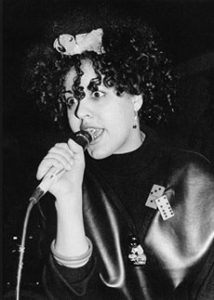
Founder and lead singer of the punk band X-Ray Spex, Styrene is known as an archetype for modern-day feminist punk (Billboard Magazine), largely because she was bi-racial, wore dental braces, stood against the typical sex object female of 1970s rock star, and sported a gaudy Dayglo wardrobe. She was “one of the least conventional front-persons in rock history, male or female.” X-Ray Spex launched their debut single in 1977.
Styrene’s overt feminism and mixed-race heritage marked her out among her punk contemporaries and won her legions of fans for generations to come. Beth Ditto, singer with Gossip, said: “Poly Styrene [was] so ahead of her time. She recreated punk,” and in this episode Moyet explains how seeing Styrene perform gave her the confidence she needed to become a performer herself.
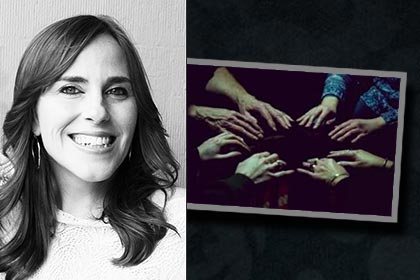

In this week’s episode Shannon Taggart talks Spiritualism and the strangest things she’s witnessed, Feminism, the Fox Sisters and Michael Jackson.
Taggart started photographing the mediums of Lily Dale in 2001, and for 16 years after has documented the séances and practices of modern Spiritualism. Taggart has curated museum exhibits on spiritualism and has photographed basement Voodoo temples for CNN and Time and her work has appeared in Newsweek. She is the author of the upcoming book Séance: Spiritualist Ritual and the Search for Ectoplasm.
Podcast: Play in new window | Download
Listen Now
Victoria Woodhull was an American leader of the woman’s suffrage movement. In 1872, Woodhull ran for President of the United States. The only place women had a platform to speak in public was in the Spiritualist community. Leaders such as Victoria Woodhull and Susan B. Anthony were able to run for office and appeal to the public on such controversial matters as equal rights was because of Spiritualist communities namely, Lily Dale, NY. Woodhull made her first fortune as a magnetic healer and went on to make her second fortune with her sister as the first women to start a Wall Street firm.


The premiere episode features the “Sweetheart of the Sideshow” Ilise S. Carter aka The Lady Aye. Carter talks frankly about why she invented a persona to get over stage fright, how swallowing swords helped her overcome bulimia, the difference between woman in the field and making a name for herself as a sword swallower, block head and fire-eater.
As an award-winning writer, Ilise S. Carter’s work has appeared in The New York Times, The AV Club, Bust, O Magazine and other outlets. As the Lady Aye, she is one of fewer than three dozen living female sword swallowers, who’s worked with everyone from Cirque de Soleil to Rob Zombie and has been called one of “the masters of modern sideshow,” by Sideshow World.
Podcast: Play in new window | Download
Listen Now
Clifford learned the art at the age of 13 and could swallow 24 swords simultaneously, razor blades, bayonets, and saws. When she was a veteran, Harry Houdini witnessed her act and was so impressed that he wrote about it in 1920 in his book “Miracle Mongers and their Methods”: “The sensation of her act was when the point of a bayonet 23 1/2 inches long and fastened to the breech of a cannon was placed in her mouth and the cannon discharged with the recoil driving the bayonet down her throat.”